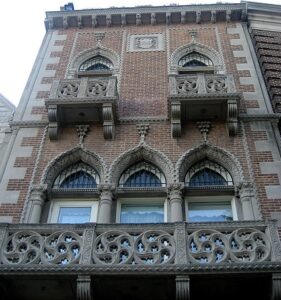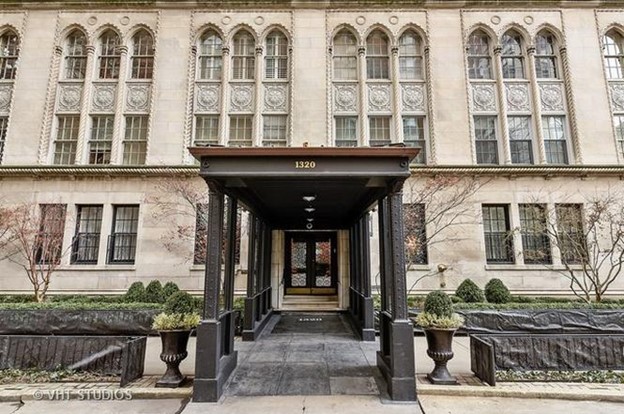
by Ron Becker, Class of 2019
Venetian Gothic is an attractive architectural style demonstrating lightness and grace with an essential element being the the ogee arch. Its revival since the middle of the nineteenth century can be contributed in part to the writings of John Ruskin, particularly his The Stones of Venice (1851-1853). In Chicago we have a striking example in the Chicago Athletic Association building on Michigan Avenue. Designed by Henry Ives Cobb in 1892-1893, it incorporates many of the elements of the paramount ideal of the style, the Doge’s Palace in Venice.


There has always been some curiosity as to why Cobb chose Venetian Gothic style for the building. One suggestion is that it was inspired by the closeness to water.

Another suggestion was that since Columbus and Venice are both Italian, it was appropriate, even though here is no notable connection between Columbus and Venice other than nationality. A third suggestion was that the style recognized the gondoliers brought over to pole the gondolas through the Grand Lagoon at the Columbian Exposition.


I think that the answer lies in the club itself. When the staunch males of Chicago formed the Chicago Athletic Association in 1892, they were emulating those east coasts metropolises of Boston (Boston Athletic Association established in 1887) and New York (Manhattan Athletic Club incorporated in 1878). When those groups built clubhouses, the Chicagoans saw a chance at one-upmanship to build a bigger and better clubhouse, reflecting the spirit of competition that existed.
Cobb was preceded in the use of the style when Holabird & Roche designed the Venetian Building, completed in 1892. The building at 15 E. Washington Street was overshadowed by its next door neighbor, the Columbus Memorial Building designed by William M. Boyington in 1891. This can be seen in the pictures below.
Holabird & Roche only used Venetian Gothic styling on the top two floors of their building. Both of the above buildings were demolished in 1957. While they were standing they shared Washington Street between State and Wabash with the Marshall Field Annex building (1892 and still extant- see above). The annex was designed by Charles Atwood of Daniel Burnham & Co,, in a Mediterranean renaissance style (Spanish or Italian?), with the block demonstrating the Columbian craze that overtook the city.
A few years later, Holabird & Roche went all in for the style, when in 1895 they designed a house for Arthur Aldis on Lake Shore Drive. The house design is based on the Palazzo Contarini Fasan- Casa di Desdemona in Venice. The house was supposedly inhabited by Desdemona, the character in William Shakespeare’s Othello.

The Arthur Aldis house is landmarked with others in a group called “Seven Houses on Lake Shore Drive”. John Ruskin wrote in his The Seven Lamps of Architecture that the palazzo was “the most elaborate piece of architecture in Venice.”
Several years later in 1927 Robert Seeley De Golyer used the style to front his apartment complex at 1320 North State Parkway. Robert S. De Golyer was educated at MIT, and, in Chicago, is noted for many excellently designed apartment buildings along Lake Shore Drive and Sheridan Road.


The Chicago-born architect, Richard Bernard Kurzon, also used the style for two automobile showrooms he designed in the mid-1920s. Kurzon was a 1917 graduate of the Armour Institute and worked for DeGolyer as a draftsman from 1919 to 1922, before he started his own firm.
The Riveria Motor Sales Company building was featured in a recent Open House Chicago, while the Capitol Motor Sales Company building has found adaptive reuse as Richard’s Body Shop. Another building in the style is a six-flat apartment building at 4822-4824 S. Martin Luther King Drive.

I am sure that members of the CAC community might be aware of other examples of this style throughout Chicagoland. Nevertheless, it remains a relatively rare style of architecture.
CLICK HERE for more stories on The Bridge.












Ron, another gem of historical storytelling. Thank you for sharing your tales with us.
Loved the pictures of the houses. Thanks Ron.
Terrific article! I wasn’t aware of these examples of Venetian architecture in the neighborhoods. Very interesting.
Thanks to Ron for a really interesting article on a rare style but one that is much less rare than I would have thought. Pictures were great., too. Thanks, Ron.